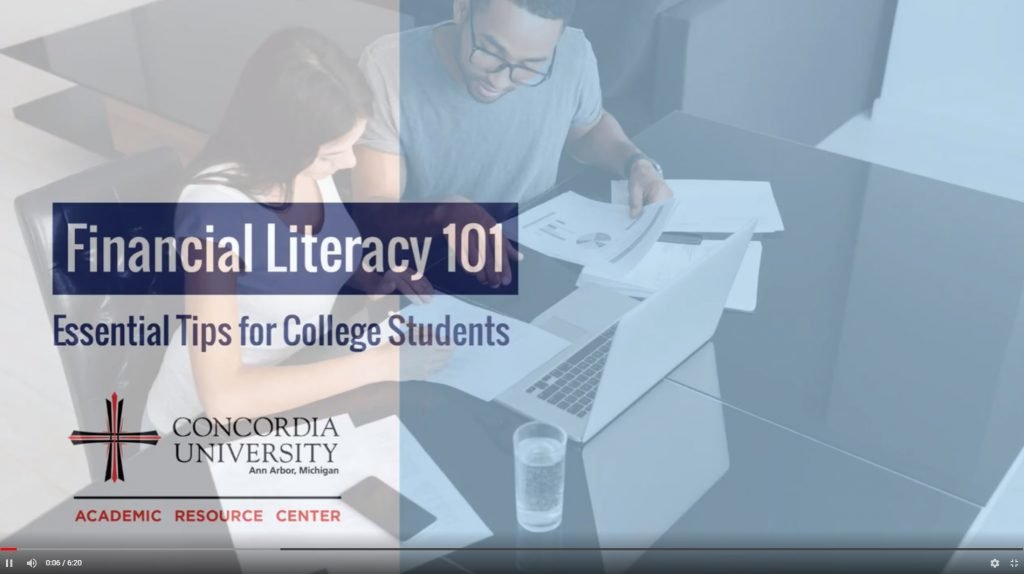
The ARC wants to make sure you get an A in Financial Literacy 101 this semester. Start the year off right with these tips!
Financial Literacy 101
College is a time of change and growth. This means taking on new responsibilities and greater independence. Financial management and personal responsibility for finances are two areas that pose a challenge for many students. Prior to starting classes, you likely never had to worry about managing a budget, paying your own bills, applying for financial aid or student loans, or balancing a checkbook. These topics may seem confusing or be a source of stress or feelings of anxiety, but they do not have to be. This is where the Academic Resource Center (ARC) comes in. We are here to provide tips and assistance that will help you become financially literate.
Being financially literate means having the ability to understand and apply financial management skills. The tips and information provided here should help start your journey towards making informed and effective decisions in the management of your finances.
Here are five areas of financial literacy and money management that are important for college students.
The True Cost of College
There is more to paying for college than just tuition. It is important to look beyond the bottom line and at a breakdown of all costs, including fees, room and board, and meal plans, to see what you’re really being asked to pay. There are also hidden expenses that won’t show up on your school bill but still factor into paying for being a student. These hidden expenses could include things like rent (if you live off-campus), food, transportation, textbooks, health insurance or medical expenses, technology needs (e.g. laptop), furnishing a dorm room or apartment, entertainment, and more. Be sure to do your homework and really think about what it will cost to be a student and how you will pay for it.
Scholarships, grants, and income from on- or off-campus employment may not be enough to cover the true cost of attending college. Student loans are an additional option that many students choose to cover their expenses. However, these should not be used without first being informed about them.
Investigate your loan options carefully by considering the following:
- Total cost of the loan after all of the interest and fees are taken into account
- APR or annual percentage rate, including whether your rate is fixed or variable
- Borrower rewards, such as cash back or interest rate reductions for making on-time payments
- Estimated monthly payment
- Deferment options
If you choose to take out student loans, here are some tips and important information for you to consider.
You should fill out the Free Application for Federal Student Aid (FAFSA) every year. You need to submit this to be considered for all types of financial aid, including loans. If you are offered student loans, always use federal loans first. Federal loans include Perkins, Direct, and PLUS loans. Federal loan benefits include:
- Lower, fixed interest rates
- Not based on credit scores but financial need
- Subsidized options offered (no interest accrued while in school)
- Loan forgiveness programs for public service workers
- More flexible repayment options, with some tied to income
If you have to use private loans, consider all the costs, including origination fees, compounding interest, and higher interest rates that may be variable (meaning they could fluctuate over time).
- Remember that many private loans are credit-based and/or require a co-signer
- Private loans may not have repayment terms that work well for you
Financial Aid
Financial aid helps students and families pay for college. This type of financial assistance can cover educational expenses such as tuition and fees, room and board, books and supplies, and transportation.There are several types of financial aid, including grants, scholarships, work study, and loans. Financial aid packages may be a combination of these types of aid.
Scholarships
These are considered “gift” aid and therefore do not need to be repaid. Scholarships can be based on a variety of factors, including academic achievement, leadership, field of study, financial need, and/or a range of personal characteristics such as where you are from, your religion, what high school you attended, whether you are a first generation college student, and more. Scholarships can come from a variety of sources, including Concordia as well as external funding sources.
Grants
These are considered “gift” aid and therefore do not need to be repaid. These funds are awarded based on financial need. An example of a grant program is the Federal Pell Grant program.
Work Study
Work study is a federal program that provides the option of part-time, on-campus employment for students who are enrolled at least part-time. Students are allowed to work a maximum of 20 hours per week on campus during the academic year, and 40 hours per week during breaks or the summer. Federal work study funds that show up on your financial aid award are not funds you are given – they are the maximum amount of money you can earn through work study employment. If earned, these funds do not need to be repaid.
Loans
As mentioned before, student loans are one option for covering the cost of college attendance. Loans are funds that are borrowed and must be repaid once you stop attending school or drop below half-time enrollment. There are many different types of student loans, but they fall into two main categories: federal and private.
Here is a breakdown of the types of loans you may be awarded through your financial aid:
- Direct Subsidized Loans: a federal loan for which the government pays interest while you are in school
- Direct Unsubsidized Loans: a federal loan for which interest accrues while you are in school but may be deferred until repayment
- Direct PLUS loans: federal loans for graduate students and parents of undergraduate students
- Private loans: loans from banks or other non-government sources
The amount of money you can borrow through loans varies based on your level of enrollment (e.g. freshman, sophomore, junior, senior, graduate student), cost of attendance, and financial need. The total amount is called your “borrowing limit.” The dollar amounts of these borrowing limits can be explained by the CUAA Financial Aid office.
Financial Aid Process
Each year, you should follow the following steps to ensure you are offered all of the financial aid you are eligible for.
- Gather your personal and financial documents for the FAFSA, including tax information. This may mean asking your parents for these documents after they have filed their taxes each year.
- Submit your FAFSA application by the priority deadline (March 1) by visiting FAFSA.gov. Remember, this must be done EVERY year you are enrolled in school.
- Review your CUAA financial aid package in the Portal or by speaking with the Financial Aid Office.
- Apply for scholarships. You can view internal and external scholarship opportunities in the Portal. Be sure to apply for the CUAA Adopt-A-Student scholarship in the Portal – it only takes 5 minutes to apply and you could be selected to receive stackable scholarship funds – this means that any funds awarded would be on top of all other aid. There are also many online lists of potential scholarship opportunities for students that you should check out, including the Community Foundation for Southeast Michigan.
- Apply for on-campus jobs if your financial aid package includes work study. You must work an eligible work study jobs to earn that portion of your aid. Log into Handshake, Concordia University’s online career engagement platform, to view on-campus employment opportunities. You can also stop by the Career Engagement Studio in the Student Services Building if you have questions about job opportunities or using Handshake.
Budgeting
Borrowing too much money, racking up credit card bills, running out of money for food or utilities…these are problems we want to help you prevent. One way to do that is by keeping a monthly budget of what you earn and what you spend. This will ensure you know where your money is going and what you have left to spend. Here are five tips to get you started.
- Figure out all of your income sources and break those down month-to-month
- Figure out all of your bills and think about them in terms of monthly expenses, not just by the semester
- Allocate funds for what you absolutely need first – think of what the essentials in your life are and plan to pay for those before anything else
- Set realistic spending goals for each month – be sure to leave room for fun in your planning
- Track your spending to ensure you stay on track – this might mean daily, weekly, and/or monthly tracking
There’s an App for That
Technology is a wonderful tool and one that can help you with your budgeting and money management. Take advantage of budgeting apps to manage and save your money and help you stay on track. Here are a few that are worth checking out: Mint, Level, You Need a Budget (YNAB), BUDGT, Daily Budget, and Spendio.
Being financially literate means having the ability to understand and apply financial management skills. The tips and information provided here should help start your journey towards making informed and effective decisions in the management of your finances.
Student Discounts
Use your status as a student to get discounts and save money. It never hurts to ask about discounts when you’re shopping around. Here are a few ideas to get you started!
- Student discounts are often available at movie theaters, restaurants, concerts, museums, and other venues around town with your ID
- Getting good grades can equal discounts on insurance, airfare, and other things. Check to see if you’re eligible!
- Shopping can get less expensive thanks to student discounts, which are available for Amazon Prime, for some gym memberships, and at stores like Michaels, JoAnn Fabric, and more
Click to view a short video reviewing these tips:
Like what you’ve seen? Want more information? Contact the ARC!
The Academic Resource Center (ARC) at Concordia University Ann Arbor (CUAA) provides free services, programs, and supports for all CUAA students so they can grow into independent learners and adjust to life as a college student.
The ARC is located on the first floor of Zimmerman Library on the main campus as well as in Room 125 at the North Building. Contact us by phone at 734-995-7460, email us at ARC@cuaa.edu, or visit our website for additional information.
—
If this story has inspired you, why not explore how you can help further Concordia's mission through giving.
